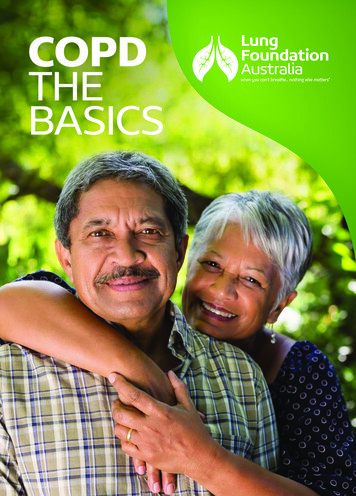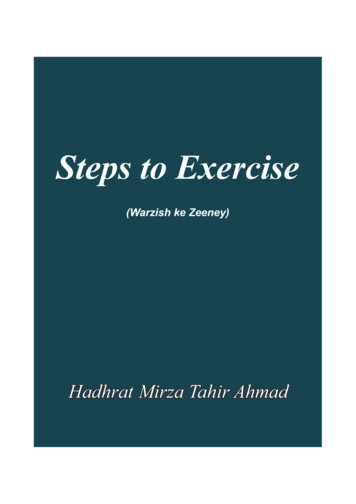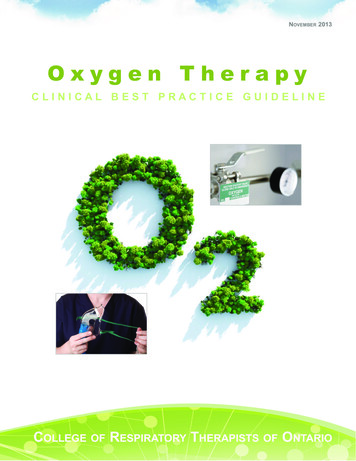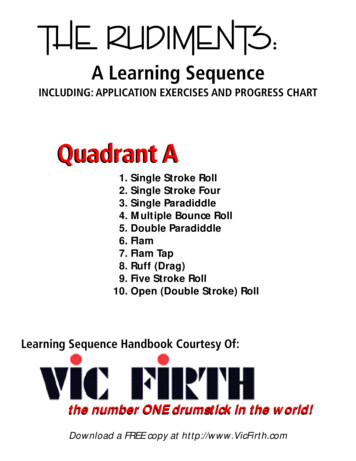
Transcription
Exercise for Someone with COPDCOPD Foundation’sSlim Skinny Reference Guide (SSRG)Exercise for Someonewith COPD
Ver2.1BIG FATREFERENCE GUIDE (BFRG)on Chronic Obstructive Pulmonary Disease (COPD)lu dSRIncGsatedUpd23-1210es 10SThis “Slim Skinny Reference Guide:Exercise for Someone with COPD”is part of the COPD Foundation’sSlim Skinny Reference Guide series which has been taken from theCOPD Big Fat Reference Guide .To access the complete COPD Big FatReference Guide , visit www.copdbfrg.org.The mission of the COPD Foundation is todevelop and support programs whichimprove the quality of life through research,education, early diagnosis, and enhancedtherapy for persons whose lives areimpacted by Chronic ObstructivePulmonary Disease (COPD).
Exercise for Someone with COPDWe all know we should exercise. But it is easy tofind excuses for not exercising. We’re too tired.We don’t feel well. We can’t find the time.And many of us just find it too boring!1
In addition, if you have COPD* you may think that you can’t exercise.You may think it will make you feel too short of breath. Or you mayfeel that it is not safe for you. You may think it will make your lungdisease much worse. But actually, avoiding exercise can make youmore unfit. You lose fitness when you stop exercising. The less youdo, the less you are able to do.Benefits of ExerciseWhat You See and FeelHelps your heart pump blood andsend oxygen to your bodyImproves how your blood circulates.Helps with the exchange of oxygenand carbon dioxideImproves energy levelIncreases muscle strengthand enduranceImproves sleepYou will have improved use of oxygenHelps your posture. Helps you beable to breathe betterMakes you aware of your body.You will be able to better knowwhat makes you feel worseIt’s fun! You can relieve stressYou will become less short of breathYou will be less tiredYou will be able to do moreYou will be able to sleep more soundly.You will wake up refreshedYou will use less energyWhile exercising you will be more awareof what makes your symptoms worseYou will learn how to control themIt will help you improve your mood. It willhelp you control anxiety*COPD is an umbrella term usedto describe the progressive lungdiseases including: emphysema(em-fa-see-ma), chronic bronchitis(kron-ick-brawn-kie-tis), refractory(re-frac-ta-ree) asthma (az-ma)and some forms of bronchiectasis(brawn-key-eck-tay-sis). If you haveCOPD you have trouble moving airin and out of your lungs becauseof damage to the airways and/orthe air sacs.2 – COPD Foundation Slim Skinny Reference GuideThe chart above shows manybenefits of exercise. But themost important benefit ofexercise for COPD patients ishow it can improve shortness ofbreath. Feeling short of breathcan make you limit your dailyactivities. The less active youare, the less you are actuallyable to do. But you can learn tocoordinate your breathing with
your activities. This will help you use less energy. You will be able tobe more active. (See the “Matching Breathing with Effort” section.)For people with moderate to severe COPD, a small amount of exercisecan improve how the heart and lungs work.But First, Talk With Your DoctorBefore you start an exercise program you need to talk about itwith your doctor. Your doctor may want you to have an exercisetolerance test. This is done using a treadmill or stationary bike.The test helps decide how much exercise you can do safely. Yourheart function and how well oxygen is getting to your body will bemeasured while you exercise. You doctor may then give you an“exercise prescription.” This will have details about how hard, howlong and how often you should exercise. If you have moderateto severe COPD, your doctor may refer you to a pulmonary(puhl-mun-nairy) rehabilitation (ree-haa-bii-li-tay-shun) program.(See the side bar at the end of this Guide.)Matching Breathing with EffortShortness of breath is one of the main reasons people with COPDthink they cannot exercise. Everyone experiences shortness ofbreath when exercising. But people who do not have COPD are ableto adjust their breathing to meet their increased need for oxygen.When you are short of breath, you feel like you cannot get enoughoxygen in your lungs. This may make you feel like you need tobreathe faster. When you breathe faster, you will be unable toempty your lungs before the next breath. This is what causes thefeeling of shortness of breath. For someone with COPD, breathingout for a longer period of time is helpful. This empties your lungs.It prepares you for the next breath.3
Matching your breathing to your movements can reduce shortnessof breath. It will also help deliver more oxygen to your workingmuscles. Coordinating or matching your breathing takes effort andpractice. Pursed-lip breathing and breathing from your diaphragm(die-a-fram) can help you match your breathing with movement.(Your diaphragm is the muscle that separates the chest cavityfrom the stomach. The diaphragm is the main muscle weuse for breathing. When the diaphragm muscle tightens,the lungs expand.)Pursed-lip breathing: In pursed-lip breathing, the lips are almostclosed while breathing out. Doing this increases the pressureneeded for breathing out. This forces the airways to stay open alittle longer. This helps you breathe out more ofthe air in your lungs. Pursed-lip breathing: Reduces your breathing rate Keeps your airways open longer Improves the exchange of oxygen andcarbon dioxide Reduces the work of breathing (neckand upper arm muscles are not needed) Increases the amount of time you can exerciseTo use pursed-lip breathing: Breathe in through the nostrils.Breathe out slowly. Do not force the air out. Breathe out throughlips pursed like you would blow out a candle or whistle. Breatheout two to three times longer than you breathe in.Pursed-lip breathing should be used during and after exercise.It should be used with any activity that makes you feel short of breath.Breathing from the diaphragm: This type of breathing is alsocalled abdominal (ab-dah-min-ul) breathing. Your abdomen shouldmove down when you breathe in. It should rise as you breathe out.4 – COPD Foundation Slim Skinny Reference Guide
To practice abdominal breathing: Place one hand on your abdomen. Place one hand on yourupper chest. Focus your breathing on your abdomen. As you breathe out, the hand on your abdomen should lower. As you breathe in, the hand on your abdomen should rise. Breathe in through the nose. Breathe out slowly throughpursed lips. Practice this 2 to 3 times a day for 5 to 10 minutes. Start bydoing it while lying on your back. Then try it while sitting. Thentry it while standing. Finally, try it while doing an activity.As you become more comfortable with this type of breathing,you can use it to reduce your feelings of shortness of breath.You can use it: With stair climbing With long walks After carrying or lifting When showering With all daily activities When exercisingFor more information on how changing your breathing can helpyou with specific activities, see the COPD Foundation’s Big FatReference GuideD, Chapter 12-B, pages 10-14. This Guide may befound at www.copdbfrg.org .Starting an Exercise ProgramAfter you’ve talked with your doctor and after you’ve learned touse your breathing in a different way, you are ready to consider anexercise program. Getting started can actually be the hardest part.5
Let’s work through the excuses you may be using to avoid startingan exercise program. You may think you are “too tired.” Exercise can actually helpyou feel less tired and give you more energy. You may think you are too busy. Think about all the thingsyou do in a day. How much time do you spend on each of thesethings? How many of these activities are more important thanyour health? To start, you only need to find 20 minutes in a day.(Over time you can increase to 30, 45, or 60 minutes.) You may think you are too sick to exercise. Ask your doctorto create a program that is right for you. The right exercises canactually help you feel better and less sick.To start a program, consider what you like to do. Exercise is easier if itis fun for you. Consider asking a friend or family member to join you.You may feel short of breath when doing your daily activities.If you do, you will need to begin your exercise program slowly.Your program should be supervised.If you are fairly active you cancreate a program that willimprove your strength. Youcan create a program thatwill improve your ability tobe active for longer periods.Start by making personal goals.Think about these questions:Do you want to decrease yourfeelings of being short of breathduring your daily activities?6 – COPD Foundation Slim Skinny Reference GuideChoose An Exercise You Enjoy: Take a class with others Follow a video in your ownhome Work out in a gym witha trainer Walk outdoors Swim Dance Bike
Do you want to have energy to join in family, social or professionalactivities?What specific activities do you want to be able to do again?What is a Good Exercise Program?An exercise program should have: Warm up and stretching: This will prepare you for the exercise.It will also help prevent injury. Stretching helps you improvethe types of movements you are able to do. This is called yourflexibility. You should stretch 5 times a week at least. You shouldstretch to the point of mild discomfort. Breathe in while youstretch. Breathe out while you hold the stretch. Hold eachstretch for 10 to 30 seconds. Repeat each stretch 3 to 5 times. Cardiovascular (car-dee-oh-vas-cue-ler) exercise: Thisincreases your blood circulation. It also improves your lung andheart function. There are many ways to do this type of exercise. You can ride a bike, walk on a treadmill or take a walk.You should do this type of exercise once a day, 3 to 5times per week. You should try to progress todoing this for 20 or 30 minutes at a time. (Talkwith your doctor about how long you should dothis type of exercise). Warm-up first. You cando this by doing the exercise at a lower effortfor 3 minutes. You should also cool downafter the exercise, for 3 minutes. Muscle strengthening: This is done using freeweights or resistive bands. It will improve yourability to work without getting tired. Makingyour muscles stronger will help you be ableto perform more tasks. Stronger muscleswill help you be more active with lesseffort. There are muscle strengtheningexercises for the upper body and lowerbody. Building up the large muscles of7
the lower body will decrease your feelings of shortness ofbreath. Strengthening the exercises of the arms and shoulderswill help you improve how you do activities using these muscles.These activities may include dressing, showering or housework.You should do this type of exercise 3 times a week. Do eachstrength exercise 10 times. Try to move to doing each exercise20 times.To get the most benefit, you should exercise on a regular schedule.You will receive the most benefit from doing a moderate amountof activity on most, if not all, days of the week. But you will stillhave some benefit if you only exercise three times per week.*For more information about the parts of an exercise program seeChapter 12-B of the Big Fat Reference Guide7 (www.copdbfrg.org).How Will I Know if I Am Exercising Enoughor Even Too Much?Exercising at a moderate level will help you increase your endurance.This means it will help you be able to be more and more active.Moderate exercise also helps improve how your lungs work.The “Borg Scale of Perceived Exertion with Exercise” can help youdecide if you are exercising at a moderate level. “Perceived Exertion”means: how hard you think you are exercising. This scale can helpyou decide how well you are exercising. It can also help you stay ata moderate level of activity.You do not need any special skills or equipment to use the BorgScale. Using the scale allows you to check on how you are doingwithout stopping to check your pulse rate.When you are exercising, try to estimate how hard you think youare working. Don’t think about any one factor such as leg pain orshortness of breath. Focus on your inner feeling of effort. Rateyour effort as honestly as you can.8 – COPD Foundation Slim Skinny Reference Guide
Borg Scale of Perceived Exertion00.512345678910Nothing at allVery, very weakVery weakWeak (light)ModerateSomewhat strongStrong (heavy)Very strongMaximal (the most you can work)Your goal should be to exercise at a 3 or 4 level on the scale.You may feel that you cannot adjust your breathing. You may feeltoo short of breath. Or you may have aches that last longer than20 or 30 minutes after exercising. If you feel any of these, reduceyour exercise level to a 1 or 2 on the scale.When should I not exercise? When you are seriously ill, a verylow level of activity is best. This may include sitting in a chair andminimal walking. When you have recently been in the hospital, youwill need to be supervised during light walking and light weighttraining. When you are having unusual symptoms, lower yourexercise level. Talk with your doctor.Yes, Safe to ExerciseNo: Not safe to ExerciseI feel tiredI feel shakyI have a headacheI am coming down from a steroid burstI am too busyI am bored and feeling lazyI am having a bad dayI feel nauseatedI am having leg pain that I cannot explainI am having chest painI am out of oxygenI have a fever or strep throat9
When should oxygen be used? Ifyou are currently on oxygen, you willneed to exercise with it. Your doctorwill need to prescribe an oxygen“flow rate” for activity. This flow ratewill be different from the flow rateyou use while resting. You will needto adjust your flow rate for about fiveminutes before you begin exercising.If your exercise is too intense for you,your oxygen prescription may need tobe changed. Or you may just need toslow down. Do not adjust your oxygen without talking with your doctor.Record Your Success and Have FunMany people find it helpful to keep a record of their exercise.You can record when you exercised, how long and how hard.As you improve, these records may encourage you to continue.You may also want to consider if you prefer to exercise alone or ina group. Some hospital’s have support groups for people with lungdisease. They may allow you to exercise together in a supervisedsetting. Mall and rec centers also have walking clubs and groupclasses. Exercising with others can be motivating.Finding an exercise program you can stick with can be hard. Thekey to success is finding something that is fun for you. And don’tforget to reward yourself when you reach small goals. These smallgoals are the steps to reaching your larger goals.The information in this Guide is not meant to replace a medicalevaluation or information from your doctor. You should ALWAYStalk with your doctor about any exercise program before you startit. Your doctor can help you know how much and how often youshould exercise.10 – COPD Foundation Slim Skinny Reference Guide
Pulmonary (puhl-mun-nairy)Rehabilitation (ree-haa-bii-lit-ay-shun)A pulmonary rehabilitation program is good for someone with COPDwho has not regularly exercised. It is also good for someone who cannotdo daily living activities without getting tired and short of breath. Theseprograms use a team approach to help you reach goals. The team helpsyou improve your quality of life. The team includes: Doctors Nurses Respiratory therapists Physical therapists Counselors Exercise therapists And more.Some insurers will not pay for pulmonaryrehab. If you are denied, ask your doctorto send them a letter. Your doctor canexplain to your insurance companywhy you need the program.11
NOTESQuestions, Ask the PMD clinical staff12 – COPD Foundation Slim Skinny Reference Guide
NOTES13
www.copdfoundation.orgCOPD Foundation20 F Street NW, Suite 200-AWashington, DC 200013300 Ponce de Leon Blvd.Miami, Florida 33134C.O.P.D. Information Line:1-866-316-COPD (2673)This Slim Skinny Reference Guide (SSRG)was created by the COPD Foundation.Take Action Today. Breathe Better Tomorrow.The contents of the Slim Skinny Reference Guide are for information purposes only.The content is not intended to be a substitute for professional medical advice, diagnosis or treatment.Any copying, modifications or distributions of the Slim Skinny Reference Guide, or any portion thereof,without the express written authorization of the COPD Foundation, is strictly forbidden.
therapy for persons whose lives are impacted by Chronic Obstructive Pulmonary Disease (COPD). BIG FAT REFERENCE GUIDE (BFRG) on Chronic Obstructive Pulmonary Disease (COPD) V e r 2. 1 u n U p d a t e d 1 0 - 2 3 - 1 2 I cl des 1 0 S S R G s. Exercise for Someone wi










